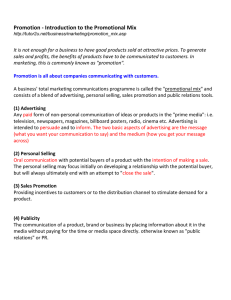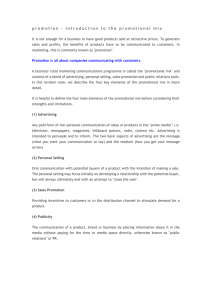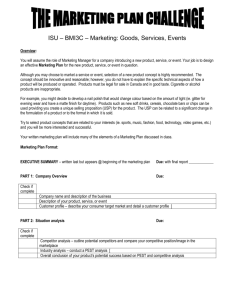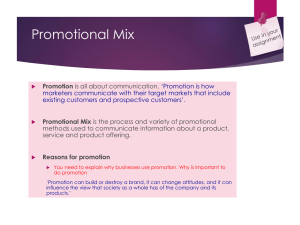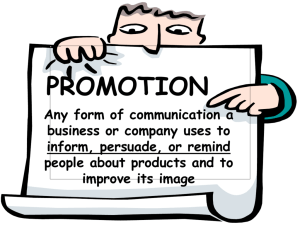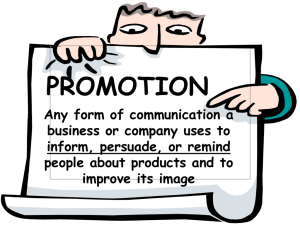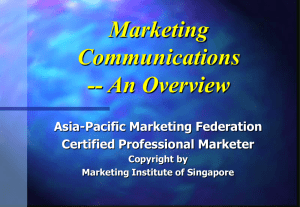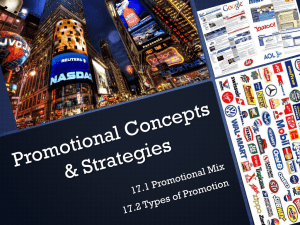Develop a Successful Promotion Program
advertisement
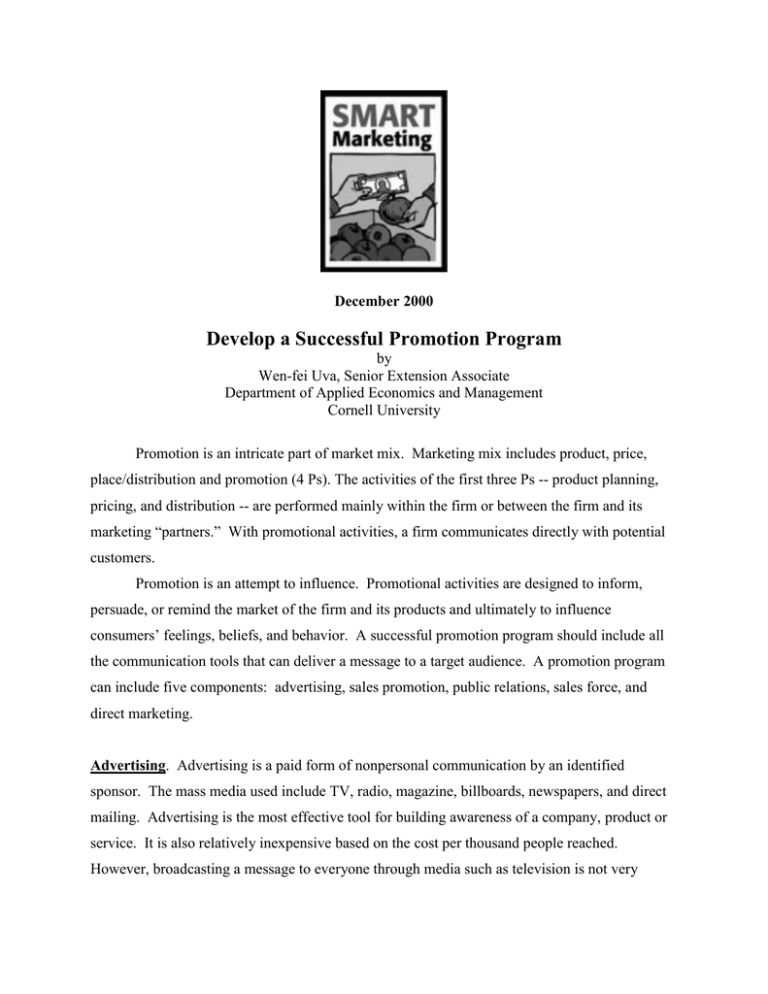
December 2000 Develop a Successful Promotion Program by Wen-fei Uva, Senior Extension Associate Department of Applied Economics and Management Cornell University Promotion is an intricate part of market mix. Marketing mix includes product, price, place/distribution and promotion (4 Ps). The activities of the first three Ps -- product planning, pricing, and distribution -- are performed mainly within the firm or between the firm and its marketing “partners.” With promotional activities, a firm communicates directly with potential customers. Promotion is an attempt to influence. Promotional activities are designed to inform, persuade, or remind the market of the firm and its products and ultimately to influence consumers’ feelings, beliefs, and behavior. A successful promotion program should include all the communication tools that can deliver a message to a target audience. A promotion program can include five components: advertising, sales promotion, public relations, sales force, and direct marketing. Advertising. Advertising is a paid form of nonpersonal communication by an identified sponsor. The mass media used include TV, radio, magazine, billboards, newspapers, and direct mailing. Advertising is the most effective tool for building awareness of a company, product or service. It is also relatively inexpensive based on the cost per thousand people reached. However, broadcasting a message to everyone through media such as television is not very targeted. The most effective advertising is narrowly targeted and uses media targeting specific audience interests. The drawback is that most advertising does not deliver sales quickly. It works mostly by changing minds, not changing behaviors. Sales Promotion. On the other hand, sales promotion changes behavior. Customers will act upon a sale, an offer, or a chance to win something. Sales promotion activities include coupons, discounts, in-store displays, trade shows, samples, in-store demonstrations, and contests. A company can also sponsor trade promotion, in which supermarkets or other retailers are given discounts to promote a specific product. However, most incentives are short-term in nature. In addition, sales promotion targeting consumers weakens consumer brand loyalty. Consumers increasingly expect to buy products below listed prices. Consumers simply buy whichever brand is on sale during a particular week and switch to a competing brand when it goes on sale. The only situation where sales promotion is profitable is when the company truly has a superior product paired with low product awareness. In this case, sales promotion will get people to try the product, and they will be less likely to switch to a competing brand when sales are over. Public Relations. Because sales promotion often loses money, and advertising is becoming less effective and expensive, companies should investigate the impact of marketing public relations. Marketing public relations is designed to create a positive image of the company to a target market. It uses non-paid communication by presenting commercially significant news in a published medium or obtaining favorable presentation of the business or product on radio or television. Tools to create publicity include publications (reports and brochures); events (sponsoring activities and trade shows); news (favorable stories about the company, its people, and products); community involvement (time or money invested in local interests); identity media (business cards, stationary, and signs); lobbying activity; and social responsibility to the environment and society. Sales Force. The more complex the product or service, the more necessary to use sales people who can answer questions and help customers. However, a company’s sales force is one of the most expensive marketing communication tools. Across all businesses, more money is spent on personal selling than on any other form of promotion. What is important is not the sales person’s costs but his/her costs in relation to the sales he/she generated. A top sales person can often sell five to ten times more than an average sales person. Companies trying to save money by paying less to the sales people often have the highest costs-to-sales ratio with high turnover rate and high training costs. In addition to hiring good people, a company should help its sales people be more productive by providing them sales tools, i.e., computers, fax machine, and e-mail, and giving them easy access to company data to help them become more informed. Sales people offer the advantage of one-on-one selling. They should be trained to consciously find out what customers want and alert the company. Direct Marketing. Direct marketing by mail, phone, or personal contact can be used to effectively communicate with a very narrowly targeted group. Lists for direct marketing purposes can be purchased from different sources. However, for direct marketing to be effective, it is important to maintain a comprehensive customer database in the company and manage the database in a way that it can be divided into subcategories for different promotional programs. All the promotional activities must be integrated to deliver a consistent and positive message. A multi-media promotion campaign is usually more effective than any promotional activity alone. For example, if a company is launching a new product or program, it can contact the media to get free press and then run an advertisement offering information, combined with offering sales promotion, direct marketing by mail or phone, and product demonstration or a visit by sales people. In developing a promotion program, a company must first determine the target audience, the most important objectives, and a promotion budget and then design the promotion activities accordingly. Promotional objectives can include providing product information, stimulating demand, increasing store traffic, differentiating products, building a brand image, reminding current customers about product benefits, countering competitors’ offers, responding to the news, smoothing out seasonal demand fluctuation, and improving customer relationships. Promotion must be integrated into a firm’s strategic planning because all elements of the market mix -product, price, place, and promotion -- must be coordinated in order for a promotion program to be successful. "Smart Marketing" is a monthly marketing newsletter for extension publication in local newsletters and to place in local media. It reviews the elements critical to successful marketing in the food and agricultural industry. Articles are written by the faculty members in the Department of Applied Economics and Management at Cornell University "Share the gift of communication." Please cite or acknowledge when using this material.
